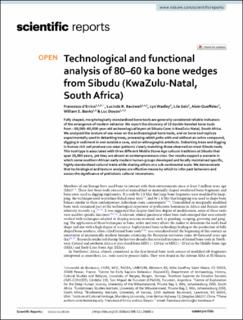| dc.contributor.author | d'Errico, Francesco | |
| dc.contributor.author | Backwell, Lucinda R. | |
| dc.contributor.author | Wadley, Lyn | |
| dc.contributor.author | Geis, Lila | |
| dc.contributor.author | Queffelec, Alain | |
| dc.contributor.author | Banks, William E. | |
| dc.contributor.author | Doyon, Luc | |
| dc.date.accessioned | 2023-03-08T10:21:03Z | |
| dc.date.available | 2023-03-08T10:21:03Z | |
| dc.date.created | 2022-11-17T10:43:38Z | |
| dc.date.issued | 2022 | |
| dc.identifier.issn | 2045-2322 | |
| dc.identifier.uri | https://hdl.handle.net/11250/3056980 | |
| dc.description.abstract | Fully shaped, morphologically standardized bone tools are generally considered reliable indicators of the emergence of modern behavior. We report the discovery of 23 double-beveled bone tools from ~ 80,000–60,000-year-old archaeological layers at Sibudu Cave in KwaZulu-Natal, South Africa. We analyzed the texture of use-wear on the archaeological bone tools, and on bone tool replicas experimentally used in debarking trees, processing rabbit pelts with and without an ochre compound, digging in sediment in and outside a cave, and on ethnographic artefacts. Debarking trees and digging in humus-rich soil produce use-wear patterns closely matching those observed on most Sibudu tools. This tool type is associated with three different Middle Stone Age cultural traditions at Sibudu that span 20,000 years, yet they are absent at contemporaneous sites. Our results support a scenario in which some southern African early modern human groups developed and locally maintained specific, highly standardized cultural traits while sharing others at a sub-continental scale. We demonstrate that technological and texture analyses are effective means by which to infer past behaviors and assess the significance of prehistoric cultural innovations. | en_US |
| dc.language.iso | eng | en_US |
| dc.publisher | Springer Nature | en_US |
| dc.rights | Navngivelse 4.0 Internasjonal | * |
| dc.rights.uri | http://creativecommons.org/licenses/by/4.0/deed.no | * |
| dc.title | Technological and functional analysis of 80–60 ka bone wedges from Sibudu (KwaZulu-Natal, South Africa) | en_US |
| dc.type | Journal article | en_US |
| dc.type | Peer reviewed | en_US |
| dc.description.version | publishedVersion | en_US |
| dc.rights.holder | Copyright 2022 the authors | en_US |
| dc.source.articlenumber | 16270 | en_US |
| cristin.ispublished | true | |
| cristin.fulltext | original | |
| cristin.qualitycode | 1 | |
| dc.identifier.doi | 10.1038/s41598-022-20680-z | |
| dc.identifier.cristin | 2075389 | |
| dc.source.journal | Scientific Reports | en_US |
| dc.relation.project | Norges forskningsråd: 262618 | en_US |
| dc.identifier.citation | Scientific Reports. 2022, 12, 16270. | en_US |
| dc.source.volume | 12 | en_US |

